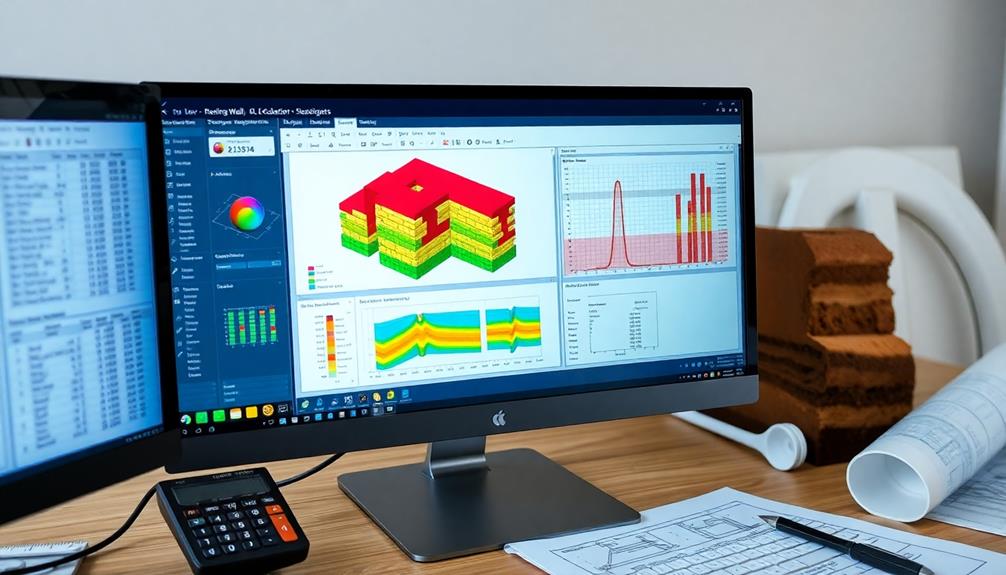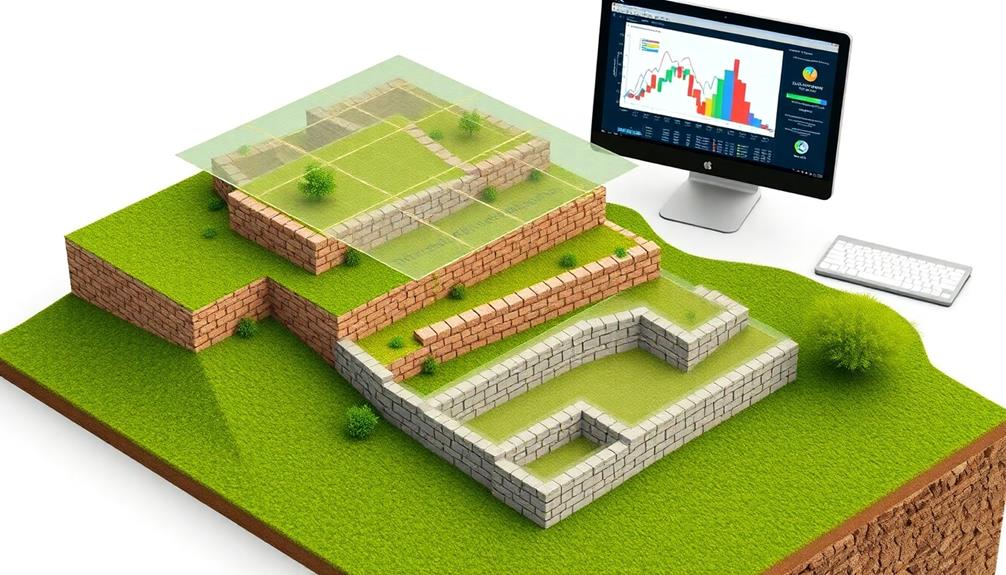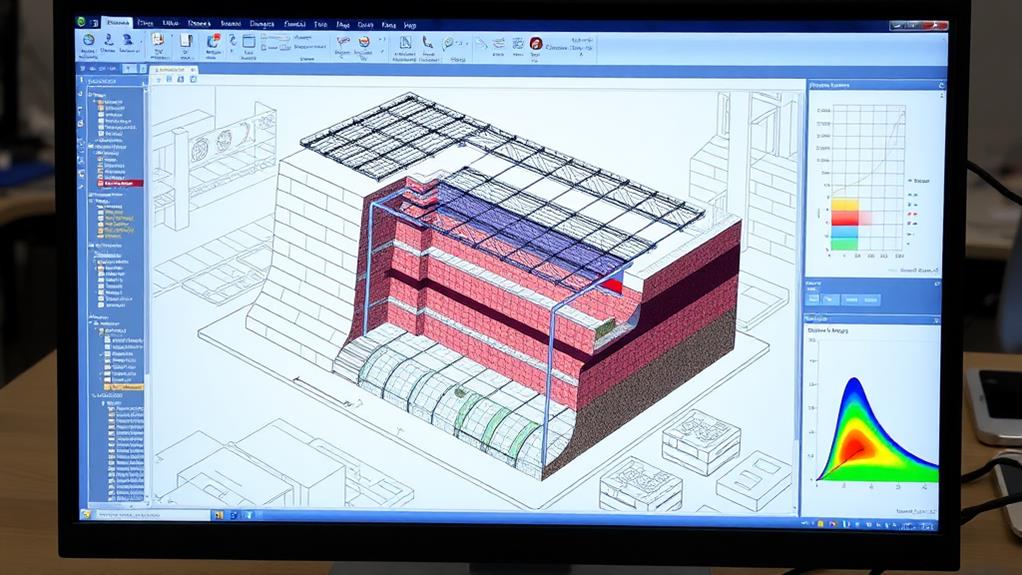Popular retaining wall engineering software packages offer holistic tools for design, analysis, and cost estimation, streamlining the complex process of creating safe and efficient retaining structures. These programs incorporate advanced algorithms for load and stability analysis, material selection, and drainage system integration. They provide automated calculations, generate detailed reports and drawings, and guarantee regulatory compliance. Many software options feature parametric modeling capabilities, cost estimation functionalities, and integration with BIM platforms. While pricing models and features vary among different packages, most offer free trials for thorough evaluation. The return on investment for these tools can be significant, potentially improving design accuracy and project efficiency. Further exploration reveals additional benefits and comparisons between leading software solutions.
Table of Contents
ToggleWalls Contractor Highlights
- Popular retaining wall software offers design automation, cost estimation, and regulatory compliance assistance.
- Key features include parametric modeling, automated calculations, and integration with material databases.
- Software streamlines design processes, reducing errors and improving efficiency in retaining wall projects.
- Pricing models vary, with options for perpetual licenses, subscriptions, and different user tiers.
- Free trials allow engineers to test software capabilities and compatibility with existing workflows before purchase.
Retaining Wall Design Calculations

Retaining wall design calculations encompass critical elements such as load and stability analysis, material selection considerations, and drainage system integration. These calculations are essential for ensuring the structural integrity and longevity of the retaining wall, taking into account factors like soil pressure, surcharge loads, and potential failure modes.
The choice of materials, such as boulder retaining walls, can markedly impact the design process and overall wall performance. Advanced engineering software streamlines this process by automating complex calculations, allowing engineers to efficiently analyze various design scenarios and optimize the wall's performance while adhering to safety standards and regulatory requirements.
Load and Stability Analysis
Concrete slabs and soil masses exert significant pressures on retaining walls, necessitating thorough load and stability analysis in the design process. Engineering software for retaining walls incorporates advanced algorithms to calculate these forces, ensuring structural integrity and longevity.
These programs meticulously evaluate factors such as soil type, groundwater conditions, and surcharge loads to determine the magnitude and distribution of lateral earth pressures acting on the wall.
The software typically employs industry-standard methods, including Coulomb's and Rankine's theories, to compute active and passive earth pressures. It then assesses the wall's stability against overturning, sliding, and bearing capacity failure modes. Engineers can input various parameters, such as wall geometry, reinforcement details, and material properties, to simulate real-world conditions accurately.
The analysis also considers external loads, seismic forces, and hydrostatic pressures, providing an in-depth evaluation of the wall's performance under diverse scenarios.
Material Selection Considerations
When designing retaining walls, material selection plays an essential role in the overall performance and longevity of the structure. Modern retaining wall engineering software offers sophisticated tools to assist engineers in making informed decisions about material choices. These programs typically include extensive databases of commonly used materials, such as concrete, steel, and various types of soil, along with their respective properties and performance characteristics.
The software allows users to input specific material parameters, including density, strength, and durability factors, to accurately model how different materials will behave under various load conditions. Engineers can then analyze the impact of material choices on factors such as wall stability, drainage capabilities, and long-term maintenance requirements. Advanced programs may also incorporate cost estimation features, enabling designers to balance performance with budgetary constraints.
Furthermore, some software packages offer the ability to simulate the effects of environmental factors, such as freeze-thaw cycles or chemical exposure, on different materials over time. This functionality helps engineers select materials that will maintain their integrity throughout the structure's intended lifespan, ensuring the retaining wall remains safe and functional for years to come.
Drainage System Integration
Proper drainage system integration is a key component of effective retaining wall design, and modern engineering software provides powerful tools to incorporate this critical element. Leading retaining wall software packages offer sophisticated modules for analyzing water flow, hydrostatic pressure, and seepage patterns, enabling engineers to optimize drainage solutions with precision and confidence.
These advanced programs allow designers to input site-specific data, including soil properties, groundwater conditions, and precipitation patterns, to simulate various drainage scenarios. By leveraging computational fluid dynamics and finite element analysis, the software can accurately predict potential water accumulation points and assess the effectiveness of proposed drainage systems. Engineers can then fine-tune their designs, incorporating features such as weep holes, French drains, and geotextile filters to guarantee long-term wall stability and performance.
Moreover, these software solutions often integrate with Building Information Modeling (BIM) platforms, facilitating seamless collaboration between geotechnical engineers, structural designers, and landscape architects. This holistic approach ensures that drainage considerations are addressed thoroughly throughout the project lifecycle, from initial concept to construction and maintenance phases, ultimately resulting in more resilient and sustainable retaining wall structures.
Benefits

Retaining wall engineering software offers numerous advantages that drastically improve the design and construction process. These sophisticated tools provide enhanced design accuracy through advanced computational models, while simultaneously offering time-saving automation features that streamline complex calculations and iterations.
Retaining wall contractors can utilize this software to guarantee proper engineering and permitting for complex retaining wall types, as well as to provide valuable advice on the best designs, materials, and methods. Additionally, the software's integrated cost estimation capabilities and regulatory compliance assistance functions enable engineers to create more efficient, code-compliant designs while maintaining better control over project budgets and timelines.
Improved Design Accuracy
Precision is the hallmark of effective retaining wall engineering software. These advanced tools notably enhance design accuracy by incorporating sophisticated algorithms and extensive data analysis capabilities. Engineers utilizing such software can attain a level of precision that surpasses traditional manual calculations, thereby reducing the margin of error and increasing the overall reliability of retaining wall designs.
The software's ability to process complex variables, such as soil properties, load distributions, and environmental factors, contributes to more accurate predictions of wall behavior under various conditions. This heightened accuracy enables engineers to optimize material usage, potentially reducing costs while maintaining structural integrity. Additionally, the software's capacity to simulate multiple scenarios allows for thorough testing of design concepts, identifying potential weaknesses or areas for improvement before construction begins.
Time-Saving Automation Features
Engineers appreciate the time-saving automation features offered by modern retaining wall engineering software. These advanced tools streamline the design process, allowing professionals to focus on critical decision-making rather than repetitive calculations. Automated analysis of soil conditions, load distributions, and material properties drastically reduces the time required for initial assessments and iterative design modifications.
The software's ability to generate comprehensive reports and detailed drawings automatically is particularly valuable. This feature not only saves time but also guarantees consistency and accuracy across project documentation. Integrated libraries of standard components and materials further expedite the design process, enabling engineers to quickly select and incorporate suitable elements into their designs. Additionally, many software packages offer automated code compliance checks, alerting users to potential issues and ensuring adherence to relevant regulations and standards.
Parametric modeling capabilities allow for rapid exploration of design alternatives, empowering engineers to optimize their solutions efficiently. By automating routine tasks and calculations, these software tools enable professionals to allocate more time to creative problem-solving and client interactions, ultimately enhancing project outcomes and fostering stronger relationships within the engineering community.
Cost Estimation Capabilities
One of the most valuable features of modern retaining wall engineering software is its robust cost estimation capabilities. These tools integrate seamlessly with design functions, providing engineers and project managers with accurate, real-time cost projections. By incorporating material prices, labor rates, and regional cost factors, the software generates comprehensive estimates that account for all aspects of the construction process.
Advanced cost estimation modules offer:
- Customizable material and labor databases
- Automatic quantity takeoffs from design specifications
- Integration with supplier pricing APIs for up-to-date costs
- Scenario modeling for cost optimization
- Exportable reports for client presentations and bids
These capabilities enable professionals to make informed decisions throughout the project lifecycle, from initial concept to final construction. By providing detailed breakdowns of expenses, the software allows for precise budgeting and helps identify potential cost-saving opportunities. This level of financial insight is vital for firms seeking to maintain a competitive edge in the industry.
In addition, the ability to quickly generate accurate cost estimates enhances client communication and fosters trust, ultimately contributing to stronger business relationships and increased project success rates.
Regulatory Compliance Assistance
While design and cost estimation are pivotal aspects of retaining wall engineering, regulatory compliance remains a cornerstone of successful project implementation. Leading software solutions in this field offer extensive regulatory compliance assistance, ensuring that engineers and project managers adhere to local, state, and federal guidelines throughout the design and construction process.
These sophisticated tools integrate up-to-date regulatory databases, providing users with instant access to relevant codes and standards. By automatically cross-referencing design parameters against applicable regulations, the software flags potential compliance issues, allowing engineers to make necessary adjustments before progressing to the construction phase. This proactive approach drastically reduces the risk of costly delays or modifications during later stages of the project.
Furthermore, many software packages offer customizable reporting features that generate detailed compliance documentation. These reports can be invaluable during permitting processes, inspections, and audits, demonstrating due diligence and adherence to regulatory requirements. By streamlining the compliance process, these tools not only save time and resources but also instill confidence in stakeholders that the retaining wall project meets all necessary safety and environmental standards.
Cost Comparison Between Programs

When evaluating retaining wall engineering software, cost considerations play a pivotal role in the decision-making process. Different programs offer varied pricing models and tiers, catering to the diverse needs of engineering firms and individual professionals. To facilitate an informed choice, it is imperative to compare not only the upfront costs but also the long-term return on investment, taking into account factors such as free trial availability and the software's potential to enhance productivity and design accuracy.
| Software | Pricing Model | Free Trial | ROI Factors |
|---|---|---|---|
| ProWall | Subscription | 30 days | Time savings, error reduction |
| RetainPro | Perpetual | 14 days | Design optimization, material cost reduction |
| WallCalc | Tiered | 7 days | Compliance assurance, project scalability |
| GeoStruct | Per-project | None | Advanced analysis, client satisfaction |
Pricing Models and Tiers
Comparing pricing models and tiers among retaining wall engineering software options is essential for businesses and professionals seeking the most cost-effective solution. Many providers offer a range of packages tailored to different user needs and budgets. These typically include basic, professional, and enterprise-level tiers, each with incrementally advanced features and capabilities.
When evaluating pricing structures, consider the following factors:
- Licensing options: perpetual vs. subscription-based models
- Number of users included in each tier
- Availability of cloud-based vs. on-premises deployment
- Access to technical support and software updates
- Integration capabilities with other engineering tools
Subscription-based models have gained popularity due to their flexibility and lower upfront costs. These often include regular updates and support, guaranteeing users always have access to the latest features and improvements. Perpetual licenses, while requiring a larger initial investment, may prove more economical for long-term use. Some providers offer hybrid models, combining elements of both approaches to cater to diverse client needs.
When selecting a pricing tier, carefully assess your organization's requirements, project volume, and anticipated growth to ensure the chosen package aligns with your operational needs and financial constraints.
Free Trials Availability
Free trials serve as a valuable tool for engineers and businesses to assess retaining wall software before committing to a purchase. Many leading software providers in this niche offer trial periods ranging from 14 to 30 days, allowing potential users to explore the full spectrum of features and functionalities. These trial periods typically grant access to all modules and tools, enabling an extensive evaluation of the software's suitability for specific project requirements.
When comparing free trials across different retaining wall engineering software packages, it is essential to consider factors such as the duration of the trial period, the extent of available features, and any limitations imposed during the trial. Some providers may restrict certain advanced functionalities or limit the number of projects that can be created during the trial phase. Additionally, the level of customer support offered during the trial period can vary greatly between software vendors.
Prospective users should take advantage of these trial periods to thoroughly test the software's interface, calculation capabilities, and compatibility with existing workflows, ensuring that the chosen solution aligns with their professional needs and enhances their engineering processes.
Return on Investment
Evaluating the return on investment (ROI) for retaining wall engineering software requires a thorough cost comparison between available programs. Engineers and firms must consider various factors beyond the initial purchase price to determine the long-term value of each software solution. These factors include licensing models, maintenance fees, upgrade costs, and potential productivity gains.
When examining ROI, professionals should consider:
- Time saved on calculations and design iterations
- Reduction in material waste through optimized designs
- Improved accuracy and reduced risk of errors
- Enhanced collaboration capabilities and project management features
- Potential for increased project capacity and revenue generation
Walls Contractor FAQ
How User-Friendly Are These Software Programs for Beginners?
The user-friendliness of these software programs varies for beginners. While some offer intuitive interfaces and tutorials, others may require more technical knowledge. It's advisable to explore trial versions and seek community support to find the most suitable option.
Can These Programs Integrate With Other Construction Management Software?
Many retaining wall engineering programs offer integration capabilities with popular construction management software. This synergy allows our team to streamline workflows, share data seamlessly, and enhance overall project efficiency. We can leverage these interconnected systems for improved collaboration and productivity.
What Level of Technical Support Is Provided by the Software Companies?
Software companies typically offer extensive technical support for their retaining wall engineering programs. This includes phone and email assistance, online documentation, tutorials, and sometimes on-site training. Support levels may vary based on the chosen subscription or package.
Are There Any Free Trials Available for These Retaining Wall Software Options?
Many retaining wall software providers offer free trials, allowing engineers to explore features and assess compatibility. These trials typically range from 14 to 30 days, giving professionals ample time to evaluate the software's suitability for their projects.
How Often Are These Software Programs Updated With New Features and Regulations?
Software update frequencies vary among providers, but most reputable companies offer regular updates to incorporate new features and align with evolving regulations. As valued members of our engineering community, we recommend checking with specific vendors for their update schedules.







